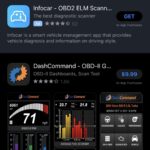Understanding your 2016 Ford Mustang’s OBD2 port is crucial for diagnostics and utilizing various aftermarket devices. This port serves as your car’s communication hub, allowing mechanics and car enthusiasts alike to tap into the vehicle’s computer system for valuable insights and functionalities. Let’s address some common questions about devices that might interface with your Mustang’s OBD2 port.
How do OBD2 Modules Work with My Mustang’s System?
Modules that connect to your 2016 Ford Mustang’s OBD2 port, like lighting control modules, often work by interpreting diagnostic signals. They send instructions to your vehicle to activate specific features without needing to alter the car’s core computer code. This process is similar to how dealerships perform diagnostics, using standardized codes to communicate with your vehicle. These modules are designed to be non-invasive, ensuring they don’t interfere with your Mustang’s overall performance.
Will Plugging in an OBD2 Module Damage My Mustang’s Computer?
A well-designed OBD2 module should not harm your 2016 Ford Mustang’s computer system. Reputable modules operate without emitting voltage that could cause damage. Think of it as plugging a USB drive into your computer – it’s a safe and direct interface for communication and added functionality. Always ensure you are using modules from trusted manufacturers that adhere to safety standards for OBD2 devices.
What Happens to My Brake Lights and Turn Signals When Using an OBD2 Lighting Module?
Safety is paramount. Even when using a module that controls lighting patterns, your 2016 Ford Mustang’s essential safety signals – brake lights and turn signals – will always take precedence. If you activate your turn signal or brakes, these signals will override any flashing patterns set by an aftermarket module. This crucial safety feature is non-negotiable and ensures clear communication to other drivers at all times.
Can an OBD2 Module Put My Mustang Into Reverse?
No, an OBD2 module designed for lighting or similar functions will not affect your 2016 Ford Mustang’s transmission or gears. However, in some vehicle models, activating reverse lights via a module might inadvertently trigger the backup camera screen due to pre-existing wiring configurations. This is a potential side effect in certain setups but does not indicate the module is interfering with your vehicle’s gear system itself.
Is There a Risk of Bulb Burnout with OBD2 Lighting Modules?
Similar to aftermarket headlight or taillight flasher systems in general, using an OBD2 module to control lighting might potentially shorten bulb life compared to normal operation. This is more relevant for traditional bulbs. Aftermarket High-Intensity Discharge (HID) bulbs, in particular, can be more susceptible to quicker burnout when subjected to flashing patterns because their ballasts are not typically designed for such rapid cycling. LEDs are generally more robust in flashing applications.
Why Might Halogen Bulbs Flash Dimly or Not at All with Some OBD2 Modules?
Halogen bulbs have inherent physical characteristics that affect flashing performance. Unlike LEDs which can switch on and off almost instantaneously, halogen bulbs require a warm-up and cool-down period. This means they are not ideal for rapid flashing. If you experience dim or inconsistent flashing with halogen bulbs when using an OBD2 lighting module on your 2016 Ford Mustang, it’s likely due to this limitation of halogen technology. Consider using custom, slower flashing patterns if your module offers that adjustability, or consider LED upgrades for more responsive flashing.
Will Using an OBD2 Module Leave a Trace After Removal?
A well-designed plug-and-play OBD2 module, when removed, should leave no trace of its installation. These modules are designed to integrate seamlessly without making permanent changes to your vehicle’s computer or wiring. This ensures a clean removal process, leaving your 2016 Ford Mustang in its original state.
